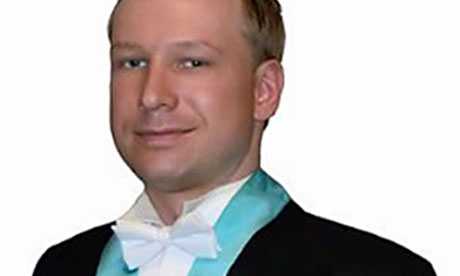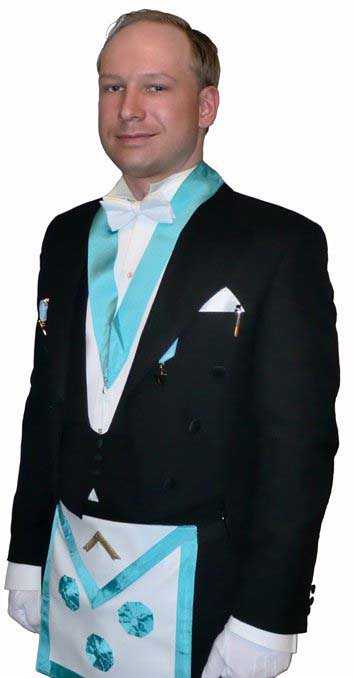Tag: Anders Behring Breivik
-
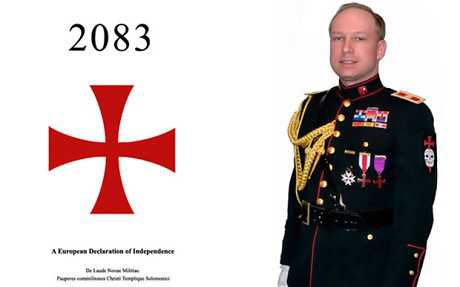
Norway killer: who were the Knights Templar?
Anders Behring Breivik’s rambling 1,500 page manifesto is replete with reference to the Knights Templar, a medieval Christian military order.

Breivik used Templar imagery in his European Declaration of Independence By Raf Sanchez
The Templar were founded around 1119 and swore to protect Christian pilgrims journeying to the Holy Land.
From its two founders, Hugues de Payens and Godfrey de Saint-Omer, the order grew rapidly and soon came to be seen as among the most skilled of the European forces struggling to reclaim Jerusalem from the Arabs.
The Templar were instantly recognisable from the blood red crosses that adorned their white tunics, a symbol Breivik adopted and put on the front page of his “2083: A European Declaration of Independence”.
The cross also appears on several of the apparently home-made uniforms he was pictured in on his Facebook page.
The knights took part in several major victories against Saladin, the leader of the Muslim forces, but by the mid-13th century the Crusades were beginning to turn decisively against the Europeans.
By 1303, the Templar had been forced out of the Holy Land and most returned to western Europe.
Many congregated in France, where there presence was seen as a growing threat to King Philip the Fair, both because of their arms and the deep debts the king owed the order after his expensive wars with England.
In 1307, the king struck and dozens of Templar were rounded up, tortured and executed.
He was aided by Pope Clement who issued a papal bull instructing all of Christendom’s monarchs to move against the order and by 1312 it was officially disbanded.
Rumours of surviving Templar have abounded, often accompanied by claims that the knights were holding a secret that could destory the Catholic church if it were ever revealed.
Today, the Templar are a potent symbol for far-right extremists of a pure and holy group of warriors who were betrayed by the corrupt order they fought to defend.
www.telegraph.co.uk, 25 Jul 2011
-
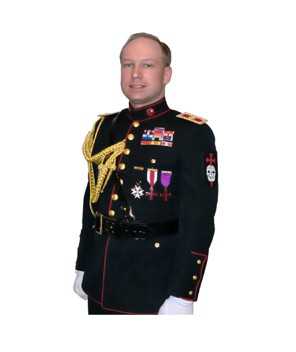
Knights Templar: Norway ‘crusader’s’ group explained

This image of Anders Behring Breivik from a manifesto attributed to him shows Breivik in a uniform with a white and red cross of the Knights Templar. (AP) By Elizabeth Flock
In a detailed diary kept by Anders Behring Breivik — the Norwegian man charged with killing at least 94 people in a bombing in Oslo and shooting on a nearby island Friday — the suspect details months of preparations that led up to the attacks.
Breivik also exhaustively references the Knights Templar, which he calls an “international Christian military order,” that “fights” against “Islamic suppression.”
Monday, it was reported that a Mexican drug ring also invoked the obscure Knights Templar.
Who are they?
The Knights Templar’s earliest function in around 1119 was to protect Christian pilgrims traveling to the Holy Land. The armed group soon became known as the most skilled in the battles to reclaim Jerusalem from the Arabs and racked up several successive victories over Muslim forces.
But by 1303, the knights had been forced out of the Holy Land and returned to western Europe. They fled to France, where they were seen as an armed threat by King Philip the Fair, who had many of them tortured and executed. The king had the support of Pope Clement V, who issued a papal bull that made sure the group was disbanded by 1312.
Since then, rumors of the surviving knights have come and gone, including one rumor that the knights could destroy the Catholic church with a single secret they held.
Breivik says the Christian military order was refounded in 2002 in London under the name PCCTS as an armed “anti-Jihad crusader-organization.”
The Templar are recognizable by white tunics with red crosses, a symbol Breivik put on the front page of his “2083: A European Declaration of Independence,” and emblazoned on homemade uniforms featured on his Facebook page.
In his diary, Breivik wrote of his plan of attack: “If you for some reason survive the operation you will be apprehended and arrested. This is the point where most heroic Knights would call it a day. However, this is not the case for a Justiciar Knight. Your arrest will mark the initiation of the propaganda phase.”
Breivik gave himself the ranking of the Justiciar Knight, and said there were up to 80 such “knights” around western Europe, all “completely unknown to our enemies.”
Breivik’s actual membership in the organization has yet to be established.
www.washingtonpost.com, 25 07 2011
-
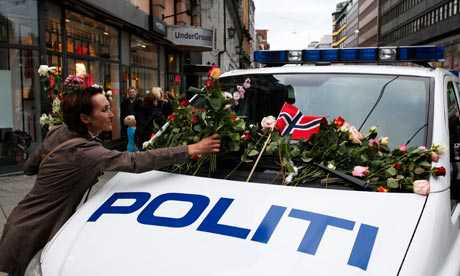
Scotland Yard called in over Breivik’s claims he met ‘mentor’ in UK
Europol ask for information because gunman wrote of visiting London for secret far-right gathering in 2002

A woman places flowers on a police car in Oslo after a memorial march to mourn the victims of Friday's bomb and shooting. Photograph: Wolfgang Rattay/Reuters Vikram Dodd and Matthew Taylor
Police attempting to piece together Anders Behring Breivik’s links to far-right groups in the UK and Europe have written to Scotland Yard asking for more officers to help with the investigation.
A specialist unit has been set up in The Hague to trawl through a database of known high-risk, rightwing extremists and assist the Norwegian police as they examine evidence from Breivik’s 1,500-page “manifesto” published online hours before he launched one of the worst mass killings in peacetime Europe.
Rob Wainwright, director of Europol, told the Guardian he had written to the Metropolitan police’s new head of counter-terrorism, Cressida Dick, asking for more officers from Scotland Yard after Breivik boasted of his links to far-right groups in the UK.
“What we’ve seen is an active extremist scene across European countries, including the UK,” said Wainwright. “There are some signs the extreme right have been more active, especially on the internet. They are more sophisticated and using social media to attract younger people.”
There are up to 50 officers already assigned to the specialist unit in The Hague, including a small number of detectives from the UK.
Breivik’s alleged links to the UK emerged in his manifesto, which details his years of meticulous planning prior to Friday’s attacks. The document was signed “Andrew Berwick” (an anglicised version of his name), written entirely in English, and datelined “London, 2011” – although security services and police say there is no further evidence at this stage to suggest it was written in the UK.
In the manuscript Breivik describes his “mentor” as an Englishman he identifies as “Richard”, and says his journey into violent extremism began at a small meeting in London in 2002 where a group of like-minded extremists met to “reform” the Knights Templar Europe, a military group whose purpose was “to seize political and military control of western European countries and implement a cultural conservative political agenda”.
The group’s name is a reference to the medieval Christian military order involved in the Crusades. It has no connection to the Knights Templar International, a long-established organisation aiming to build “bridges throughout the world for peace and understanding”, and which has issued a statement deploring Breivik’s “senseless acts of terrorism”.
In his manifesto Breivik said the gathering in London was “not a stereotypical ‘rightwing’ meeting full of underprivileged, racist skinheads with a short temper”. Instead, he claimed those present were successful entrepreneurs, “business or political leaders, some with families, most Christian conservatives, but also some agnostics and even atheists”.
Breivik said the handful of far-right activists had travelled to London from across Europe, and most had not met each other before. He did not name those present, but claims two of them, including the host, were English, as well as one French, one German, one Dutch, one Greek, one Russian and one Serbian.
“They obviously wanted resourceful, pragmatical [sic] individuals who were able to keep information away from their loved ones and who were not in any way flagged by their governments.”
At 23 years old, Breivik says he was the youngest person at the meeting, and had first been put in contact with others in the group by a “Serbian crusader commander”.
At the end of the sessions, he says, he was “ordinated as the 8th justicar knight for the PCCTS, Knights Templar Europe” – the name he uses to sign off the last entry in his diary before carrying out Friday’s attacks.
It was at this meeting that he also claims to have struck up his friendship with his mentor. Breivik says he and “Richard”, who took the pseudonym in reference to Richard the Lionheart, had a “relatively close relationship”.
According to the document, the meeting in London was followed by two larger events held in “Balticum” which attracted people from all over Europe. He says there was a high level of security at the gatherings, adding that those attending were told not to communicate to people outside.
“Some of us were unfamiliar with each other beforehand, so I guess we all took a high risk meeting face to face … electronic or telephonic communication was completely prohibited, before, during and after the meetings. On our last meeting it was emphasised clearly that we cut off contact indefinitely. Any type of contact with other cells was strictly prohibited.”
Breivik also boasted about links to the UK far-right group the English Defence League. He mentioned the group several times in the manifesto and claimed he had “spoken with tens of EDL members and leaders … [supplying] them with processed ideological material (including rhetorical strategies) in the very beginning.”
The EDL – which has staged a series of street demonstrations, many of which have turned violent, since it was formed two years ago – issued a statement on Sunday condemning the killings and denying any links with Breivik. It added that the league was a peaceful organisation which rejected all forms of extremism.
In the closed court hearing on Monday, Breivik claimed he belonged to an organisation with two more cells that remain at large, although he did not give more details. Wainwright, the Europol director, said police were working flat out to try and establish whether Breivik had help from far-right groups and activists in the UK and across Europe.
“We’re pursuing a number of lines of inquiry. It is difficult to tell if he had active support from outside Norway,” he said.
www.guardian.co.uk, 25 July 2011
-
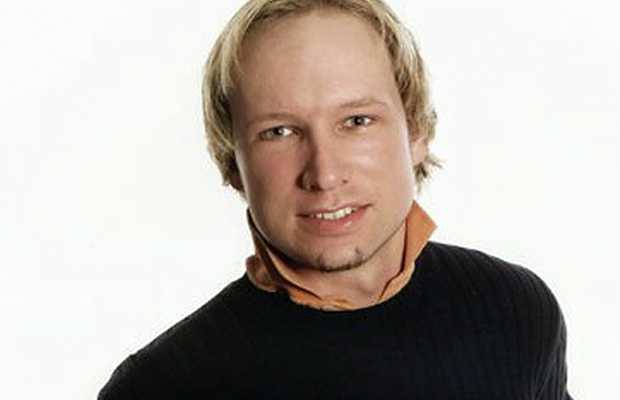
Hunt for Britons linked to Norway killer Anders Behring Breivik
 A hunt for possible British accomplices of the mass murderer Anders Behring Breivik is under way after it emerged that he began his deadly “crusade” after meeting other Right-wing extremists in London.
A hunt for possible British accomplices of the mass murderer Anders Behring Breivik is under way after it emerged that he began his deadly “crusade” after meeting other Right-wing extremists in London.Before he carried out Norway’s worst terrorist atrocity, Breivik typed out a chilling 1,500-page description of his plans, written entirely in English and datelined “London, 2011”.
He signed the document “Andrew Berwick”, an Anglicised version of his name, and described his “mentor” as an Englishman he identified as Richard.
Scotland Yard counter-terrorism officers are now trying to establish whether Breivik visited London in recent years and whether he was part of a wider network preparing to carry out similar attacks.
The 32 year-old boasted that he was just one of up to 80 “solo martyr cells” recruited throughout Western Europe who were ready to follow his example of trying to overthrow governments tolerant of Islam.
He said he regarded himself as a successor to the medieval Knights Templar, and claimed to have been recruited at a meeting in London in April 2002, which was hosted by two English extremists and attended by eight people in total.
Any member of a political group that has allowed Muslims to migrate to their country is regarded as a “target” who deserves “the death penalty”, according to his writings.
He also spoke of being in touch with the far-Right English Defence League and made repeated references to British politicians, including Gordon Brown and Tony Blair, who were blamed for making London a global hub of Islamic terrorism.
In other developments yesterday:
• The death toll in the twin attacks on Oslo and the island of Utoya rose to 93, with five others still missing.
• Breivik’s father, a retired diplomat who once served in London, spoke of his “absolute horror”.
• Norwegian police were caught out despite having issued a warning in March of the danger that far-Right groups could be planning an attack.
• It emerged that the police response to the massacre on Utoya was hampered when a boat was overloaded with equipment and its motor stopped
• Breivik’s lawyer said his client regarded his actions as “atrocious but necessary”.
At a memorial service yesterday, Jens Stoltenberg, the Norwegian prime minister, was joined by the country’s king and queen in mourning the “national tragedy”.
Breivik spent nine years planning Friday’s atrocity, and spent three years writing his manifesto A European Declaration of Independence, which was emailed to 5,700 people hours before he detonated a bomb in Oslo.
The bomb, he made clear, was merely a diversion designed to draw police away from the real target, the Labour Party summer camp on Utoya. He even discussed his reason for disguising himself as a policeman — to cause “confusion and hesitation”.
But it is his detailed descriptions of meetings with British accomplices that has led to fears he may be part of a network of Right-wingers intent on mass murder.
Scotland Yard’s domestic extremism unit is trying to identify the seven other people who attended the inaugural meeting of the “European Military Order and Criminal Tribunal” of the “Knights Templar” in London in April 2002.
He wrote: “The order is to serve as an armed Indigenous Rights Organisation and as a Crusader Movement” and said the session was hosted by an English Protestant. Another English extremist was also present as well as French, German, Greek, Dutch and Russian delegates.
He also said an Englishman became his mentor. “He was the one who first described the ‘perfect knight’ … let’s call him Richard.”
He added that most of those at the meeting “were successful entrepreneurs, business or political leaders”.
A Scotland Yard source said Breivik was not thought to have visited Britain this year, but police were “making inquiries into any possible links to British extremists and liaising with the Norwegian authorities”.
MI5 is not currently involved in tracking down Right-wing extremists but sources admitted the attacks could force a change of tactics. One of the largest arms caches found in recent years in England was in the possession of a Right-wing terrorist in Yorkshire two years ago.
Breivik claimed to have had online conversations with members of the English Defence League and urged “them to use conscious strategies”. However, he dismissed the group as “naive fools” for refusing to sanction violence.
The EDL issued a statement saying: “We can categorically state that there has never been any official contact between him and the EDL.”
Breivik also wrote of using dum-dum bullets to cause maximum injury, and surgeons confirmed so many of his victims died because he had used similar ammunition.
Dr Colin Poole, from Ringriket Hospital in Honefoss, north-west of Oslo, said: “These bullets more or less exploded inside the body.”
Breivik even harboured ambitions of acquiring a nuclear weapon to hold Western governments to ransom and discussed the merits of using biological and chemical weapons to kill up to two million people.
The Telegraph
-
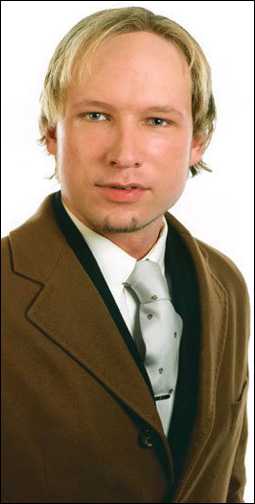
Single White Norway Psychopath Killer: Anders Behring Breivik, 32, Nationalist, Hates Islam
 Perhaps it is time for the Telegraph to issue a retraction to its kneejerk publication in which it automatically cast blame on Islamists and other “eastern” terrorists-by-default.
Perhaps it is time for the Telegraph to issue a retraction to its kneejerk publication in which it automatically cast blame on Islamists and other “eastern” terrorists-by-default.Because according to just released info, they could not have been more wrong, and it is the reaction to precisely this type of prejudice that will never facilitate bridging frayed relations between disparate cultures. Anyway, so much for prejudiced speculation and/or lies about some Islamist organization taking the blame for the events in Norway today.
Here is the truth:” VG has received confirmation from several independent sources that it was Anders Behring Breivik, who was arrested by armed police after the mass killings of Utøya Friday. VG was also present when the emergency squad took action against the flat 32-year-old susceptible west of Oslo. Several foreign media have also named Breivik as the perpetrator.” More on his motives: “A childhood friend of Breivik says to VG Nett that he should have been right-wing in the late 20’s, and posted a series of controversial opinions on Facebook.” And the kicker, for all the bigots out there: he was an ultra nationalist who hated Islam. Today’s tragic events were merely the outburst of deranged and very much troubled Loughner, McVey-like psychophath. And nothing more.
In online debates he makes his mark as a well-read, and one with strong opinions about Norwegian politics. He promotes a very conservative opinions, which he also called nationalist. He expresses himself strongly opposed to multiculturalism – that cultural differences can live together in a community.
He has had many posts on the site Document.no, an Islam-critical site that publishes news and commentary.
In one of the posts he states that politics today no longer revolves around socialism against capitalism, but that the fight is between nationalism and internationalism. He expressed clear support for the nationalist mindset.
He also commented on the Swedish news articles, where he makes it clear that he believes the media have failed by not being “NOK” Islam-critical.
There is more in the full article here but the gist is clear: this is a case where blaming Islamist or Jihadist jingoism is about as far from the truth as possible.
Zero Hedge

